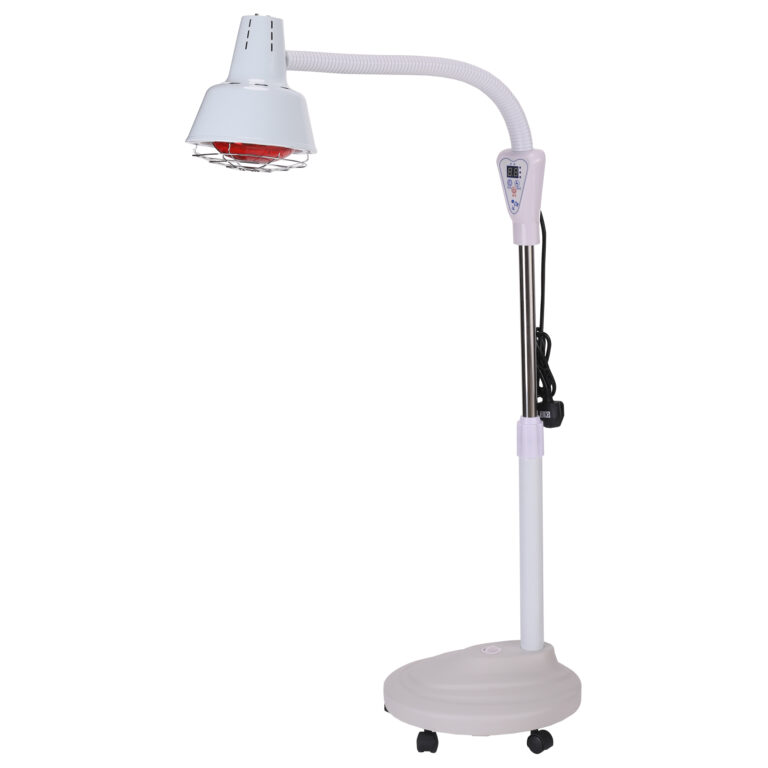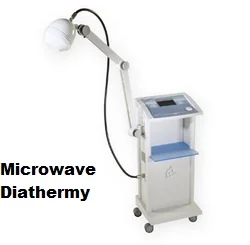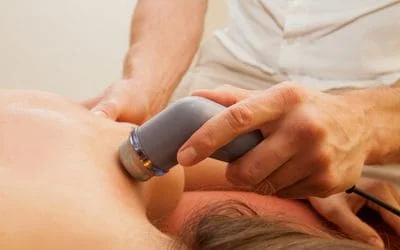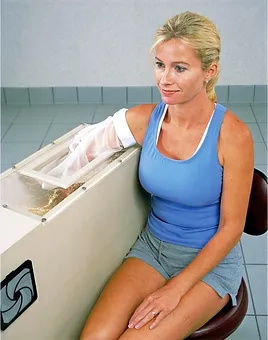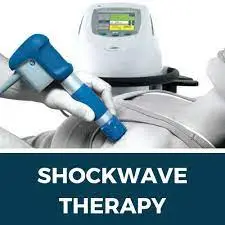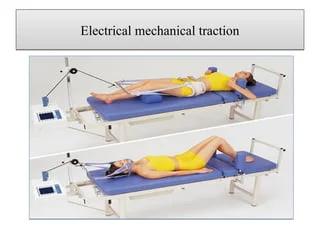Infrared Radiation Therapy
What is Infrared Radiation Therapy?
Infrared radiation treatment, often known as light therapy, is used in physiotherapy to relieve acute or chronic pain (mostly joint and muscular pain) in patients. In this therapy, different wavelengths of light are focused on the injured regions of the body.
Infrared light can penetrate the skin layers and offer significantly more depth. This can lead to more effective pain alleviation.
This technique of physiotherapy is natural and painless, and it can deliver several health advantages while causing no skin injury.
Infrared (IR), often known as thermal radiation, is an energy band that exists throughout the electromagnetic spectrum. IR radiations have longer wavelengths than the red end of the visible spectrum and extend to the microwave area, ranging from 760 nm to 1 mm.
The Sun generates IR radiation.
Many traditional remedies use sunlight to treat wounds and relieve pain. When sunlight reaches the ground, it is absorbed by atmospheric gases or water molecules. Because the human body is 70% water, it can build up a significant quantity of energy that can control biological processes through intense resonant absorption of IR radiation from sunlight via water molecules.
How does infrared therapy work?
infrared therapy penetrates the interior layer of the skin depth of 2 to 7 cm, it can reach the muscles, nerves, or even bones. As a result, it is considered one of the most efficient treatments for treating inflammatory diseases. Infrared light is absorbed by photoreceptors in cells, activating a sequence of metabolic activities at the cellular level.
Nitric oxide is thought to contribute to the efficacy of infrared light treatment. It is a chemical that is essential to the health of the body’s arteries. Nitric oxide can aid in relaxing the arteries, inhibit platelet accumulation in the vessels, combat free radicals to minimize oxidative stress, and control blood pressure.
With all of this, blood circulation improves, delivering important nutrients and oxygen to wounded bodily parts.
As a result, this therapy accelerates the repair and regeneration of wounded tissues, thereby reducing pain and inflammation.
Infrared radiation may improve skin health by:
- Stimulate collagen formation, which provides skin structure, strength, and suppleness.
- Increase fibroblast production, which creates collagen. Collagen is a kind of connective tissue found in the skin.
- Increase blood flow to the tissues.
- Reduce cellular inflammation.
Characteristics of Infrared Radiation:
Infrared radiation produces heat. These rays have uses in heat generation. It has therapeutic use in physical therapy. The change stems from a modification in electron mobility.
wavelength range: 710 nm to 1mm.
Frequency range: 430 THz to 300 GHz.
Infrared radiation is a transverse wave.
The speed is 3 x 108 m/s.
It demonstrates the property of refraction.
Thermal Properties: Displaying heat-inducing properties.
What are the health benefits of using infrared therapy?
Cardiovascular Health
One of the primary health benefits of infrared treatment is improved cardiovascular health. Infrared light stimulates the creation of nitric oxide, a crucial signaling chemical required for blood vessel health. This chemical helps to relax the arteries and keep blood from clotting and clumping in the vessels. Aside from that, it fights free radicals to avoid oxidative stress and maintains blood pressure.
Nitric oxide is crucial for increasing blood circulation, which delivers more oxygen and nutrients to wounded tissues. infrared light accelerates the healing of wounds and the regeneration of wound tissue, lowering discomfort and inflammation.
Pain and inflammation
Infrared therapy is an efficient and safe treatment for pain and inflammation. It can penetrate deeply into the skin’s layers, reaching the muscles and bones. Because infrared treatment stimulates and increases circulation in the skin and other regions of the body, it can transport oxygen and nutrients to wounded tissues, facilitating healing. It eases pain, reduces inflammation, and protects against oxidative damage.
Muscular injuries
Infrared treatment increases mitochondrial function inside cells, promoting the development and repair of new muscle cells and tissues. In other words, infrared light helps speed up the healing process following a muscle injury.
Detoxification
Saunas are capable of providing infrared treatment. Detoxifications are crucial because they can boost the immune system. At the same time, detoxification promotes normal biochemical processes, which improves food digestion. Infrared saunas raise the body’s core temperature, which promotes cellular cleansing.
Potential Cancer Cure
Infrared therapy is a potentially effective cancer treatment. Studies demonstrate that when nanoparticles are exposed to infrared light, they become significantly activated, making them very dangerous to surrounding cancer cells. One such technique is photoimmunotherapy, which employs a conjugated antibody-photo absorber combination that attaches to cancer cells.
What kinds of skin disorders are being treated using infrared radiation therapy?
Infrared radiation therapy is advocated as a treatment for various common skin disorders, such as:
- Improve wound healing.
- Reduce stretch marks.
- Reduce wrinkles, fine lines, and age spots.
- Improve your face texture.
- Improve psoriasis and eczema.
- Improve scars.
- Improve sunburned skin.
- Improve hair growth in persons suffering from androgenic alopecia.
- Improve acne.
The classification of infrared radiation depends on:
- CIE (International Commission on Illumination)
- ISO 20473 (International Organisation for Standardisation)
CIE (International Commission on Illumination)
| Type | Wavelength | Photon energy (Hz) |
| IR A | 0.7 – 1.4µm(700-1400nm) | 215-430 |
| IR B | 1.4-3.0µm(1400-3000nm) | 100-215 |
| IR C | 3.0-100µm(3000nm-0.1mm) | 3-100 |
ISO 20473 (International Organisation for Standardisation)
| Type | Wavelength |
| Near IR | 0.78-3 |
| Mild IR | 3-50 |
| Far IR | 50-1000 |
Production of Infrared radiation :
Source of IRR:
It has two methods:-
- Natural: sun
- Artificial: Luminous(visible) & Non-Luminous ( invisible)
Types of Infrared Generators:
Energy penetration into a medium is proportional to the intensity of the infrared source. Infrared radiation is produced in two kinds luminous and non-luminous radiation. the shorter rays of the luminous generator are more useful in chronic lesions. Still, in acute inflammatory disease, the non-luminous generator is used, because of the calming impact of the rays which may be more efficient in reducing pain.
Luminous IR Generator
The luminous generator is simple to operate and emits infrared rays with visible light. One or more incandescent lights create the rays released by the luminescent generators. An incandescent lamp is made out of a wire filament contained in a glass bulb. The filament is a tiny wire coil that is often constructed of tungsten because it can withstand the heat and cooling associated with the process.
The passage of an electric current across the filament generates heat, infrared, and a few UV rays. The lamp’s glass absorbs the shorter, visible ultraviolet generated, so it is not released. The lamp now produces infrared light with wavelengths ranging from 780nm to 1500nm, with a peak intensity of 1000nm. luminous generator also known as radiant heat, may penetrate the dermis and subcutaneous tissue to a depth of 5-10nm.
Non-Luminous IR Generator
It is a mechanism intended to emit solely infrared rays and not visible light. These generators use a coiled resistance wire that is wrapped around or placed in a ceramic insulating substance to produce infrared electromagnetic radiation.
Infrared radiation will be emitted, and these generators are commonly available with power levels ranging from 750 to 1000W. The infrared emitter is located at the focal point of a parabolic reflector, which reflects the radiation into a nearly uniform beam. The reflector’s front is covered with wire mesh. These generators emit radiation with a wavelength of approximately 4µm (4000nm) and may penetrate the epidermis up to 2mm.
Non-bright lamps take longer than luminous lamps to attain a maximum level of heat output due to the thermal inertia of a large amount of metal and insulating material that must be heated. Small lights may take 5 minutes, while bigger ones may take up to 15 minutes to attain maximum emission.
Apparatus choice for Infrared radiation Therapy:
Infrared radiation therapy can employ both luminous and non-luminous generators, however one may be more effective for certain conditions.
Acute inflammation or recent damage = non-luminous generators.
Chronic Injury = Luminous Generators
One surface of the body = one element put in a reflector is sufficient.
Several features = Tunnel bath.
How to prepare the patient for infrared radiation therapy:
To prepare for infrared radiation therapy, arrange the patient in a comfortable posture and remove clothing from the afflicted area.
First, assess the skin feeling [hot and cold].
Instruct the patient for acceptable warmth; if there is excessive heat, please notify the therapist and never touch the light.
During therapy, the patient does not move.
The patient’s face is not exposed.
Eyes must be guarded.
Remove any metal items, including rings and safety pins.
Arrangement of patients and lamp for Infrared radiation Therapy:
Infrared radiation therapy involves positioning the light opposite the center of the treatment region.
The rays strike the skin at the appropriate angles, resulting in optimal absorption.
The lamp should be 75 or 50 cm away from the patient and pre-heated for at least 5 minutes before use.
Application of Infrared Radiation Therapy:
At the moment of exposure, the intensity is low.
When vasodilation occurs and blood flow increases, the radiation’s intensity may rise.
This is accomplished by bringing the light closer to the patients or altering the variable resistance.
After treatment, the skin should be red.
After treatment, the patient should not quickly move from a recumbent position or go outside into the cold.
Dosage for Infrared Radiation Therapy:
Duration: 10 to 15 minutes.
During the day: numerous times
The voltage of the equipment emitter ranges from 250 to 1000 watts.
Wavelength: 800 to 1200 nm.
Physiological Effects of Infrared Radiation Therapy:
After 1-2 minutes, local cutaneous vasodilation develops as a result of the production of a chemical vasodilator (histamine) and its potential influence on the blood vessels.
Evident erythema = The pace and severity of erythema are determined by the rate and degree of heating.
Reflex dilation of other cutaneous vessels = maintaining adequate heat balance
Prolonged warmth causes moisture, which finally leads to cooling.
A warm sensation occurs when the thermal heat receptor is stimulated.
Increased metabolism = According to Vant Hoff’s rule, chemical reactions are accelerated by heat. The heat produced by infrared radiation enhances metabolism, resulting in an increased demand in the tissue for oxygen and nutrients, which is sustained by increased arterial flow.
Nerve stimulation = The effects of heating stimulate thermal heat receptors in the skin.
Therapeutic Benefits of Infrared Radiation Therapy:
- Pain reduction.
- Decrease of muscular spasms
- Joint stiffness
- Edoema Relief
- Skin lesion (psoriatic arthritis and psoriasis).
- Skin ulcers (pressure ulcers)
- Increases the sensory nerve conduction velocity.
- An increase in endorphins influences the pain gate mechanism.
- Increase blood supply and joint mobility.
- Muscle relaxation
Benefits of Infrared Radiation Therapy:
Infrared light promotes cell regeneration and repair.
Infrared light can provide several health advantages, ranging from pain alleviation to reduced inflammation.
Infrared light is safer than ultraviolet light, which can harm the body’s cells and tissues.
Infrared treatment technology allows individuals to benefit from sunshine while avoiding damaging UV radiation.
It promotes the circulation of blood in the body, and it results in the speed of healing of deep tissues.
It has been widely utilized to alleviate pain caused by sports injuries, boost endorphin levels, and bioactivate neuromodulators.
Infrared treatment has no adverse effects.
It is even used on neonates in neonatal intensive care.
Infrared radiation has been shown to benefit cardiovascular health.
Its molecule, nitric oxide, plays a crucial role in maintaining blood vessel health.
Infrared radiation treatment has demonstrated remarkable health benefits in detoxifying the body.
Detoxification can occur in major organs such as the kidneys, respiratory system, liver, and many others.
Indication for Infrared Radiation Therapy:
- Osteoarthritis
- Bursitis
- Backache.
- Blunt trauma.
- Muscle strain.
- Neck pain.
- Carpal Tunnel Syndrome
- Diabetic neuropathy
- Rheumatoid arthritis and sciatica
- Temporal mandibular joint discomfort.
- Tendinitis and Wounds
- Surgical incisions.
- Spinal injury.
- Sports injuries.
- Tennis elbow
Contraindications to Infrared Radiation Therapy:
- Impaired cutaneous thermal sensations.
- Defective arterial-cutaneous circulation.
- Dermatitis or Eczema
- Tumors
- Skin injury from ionizing radiation
- Fever
- Patients with advanced cardiovascular disease.
- Hemorrhage
- Scar tissue or tissue devitalized by deep X-rays or other ionizing radiations.
- Superficial infections.
The risks of infrared radiation therapy:-
- Burns and skin discomfort.
- Eye damage.
- Dehydration
- Low BP
- Electrical shock
- Gangrene
- Headache
- Faintness
- Injury at the edge
Precautions for Infrared Radiation Therapy:
- Pregnant women.
- Hip or knee replacement
- metal implants in their bodies.
- Photosensitive medications
FAQs
How is infrared utilized in physiotherapy?
Infrared is utilized in physical therapy for the following reasons:
Pain alleviation.
Reduces muscular spasms.
Improves sensory nerve conduction.
Increases endorphin production.
What defines luminous and non-luminous generators?
Luminous generators convert visible light into infrared radiation. The rays released by the generator are created by one or more incandescent bulbs. The non-luminous generator, on the other hand, emits infrared rays in the absence of visible light.
What are the advantages of infrared radiation?
Infrared radiation has a variety of advantages, including detoxification, pain treatment, muscular tension reduction, weight loss, increased circulation, immune system improvement, blood pressure decrease, skin cleansing, and reduced diabetic side effects.
When would you utilize infrared therapy?
it is used to treat arthritis, back pain, carpal tunnel syndrome, and diabetic neuropathy. The therapy focuses mostly on detoxification, pain alleviation, relaxation, circulation, and skin cleaning.
What is the purpose of infrared radiation therapy?
Infrared radiation can improve local blood circulation and relieve muscular tension.
What are the negative aspects of using infrared radiation therapy?
Burns: You may be burned if the technician applies too much heat to a specific region during IR therapy. Eye Damage: Radiation may harm the eyes. Excessive perspiration and fluid imbalance might result in dehydration.
Who shouldn’t use infrared therapy?
We do not advocate utilizing an infrared sauna if you are sensitive to heat, have a fever, have a disease that prevents you from sweating, or have a pacemaker or defibrillator.
How many minutes of red light treatment do you get each day?
To begin, we recommend employing red light treatment three to five times each week for ten to twenty minutes.
References
- P. (2022, December 27). Infrared Radiation Therapy in Physiotherapy. https://www.physiotattva.com/blog/infrared-radiation-therapy-in-physiotherapy
- Infrared Therapy: Health Benefits and Risks. (2019, January 30). News-Medical. https://www.news-medical.net/health/Infrared-Therapy-Health-Benefits-and-Risks.aspx
- Ladva, V. (2021, October 25). Infrared radiation Therapy light : Physiotherapy Treatment. Mobile Physiotherapy Clinic. https://mobilephysiotherapyclinic.in/infrared-radiation-therapy/
- Infrared Radiation, Definition, Characteristics, Applications and Examples. (2021, February 4). Toppr-guides. https://www.toppr.com/guides/physics/electromagnetism/infrared-radiation/
- Professional, C. C. M. (n.d.). Red Light Therapy. Cleveland Clinic. https://my.clevelandclinic.org/health/articles/22114-red-light-therapy

